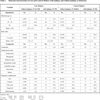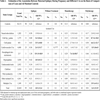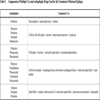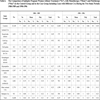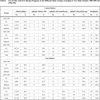- Home
- About Journals
-
Information for Authors/ReviewersEditorial Policies
Publication Fee
Publication Cycle - Process Flowchart
Online Manuscript Submission and Tracking System
Publishing Ethics and Rectitude
Authorship
Author Benefits
Reviewer Guidelines
Guest Editor Guidelines
Peer Review Workflow
Quick Track Option
Copyediting Services
Bentham Open Membership
Bentham Open Advisory Board
Archiving Policies
Fabricating and Stating False Information
Post Publication Discussions and Corrections
Editorial Management
Advertise With Us
Funding Agencies
Rate List
Kudos
General FAQs
Special Fee Waivers and Discounts
- Contact
- Help
- About Us
- Search

The Open Drug Safety Journal
(Discontinued)
ISSN: 1876-8180 ― Volume 4, 2013
Critical Evaluation of Antiepileptic Drugs in Epileptic Pregnant Women - Hungarian Experiences
Andrew E Czeizel*, Ferenc Bánhidy
Abstract
The prevalence of epilepsy is 0.3-0.6% in pregnant women and the higher rate of structural birth defects, i.e. congenital abnormalities (CAs) was recognized in their children. There are four aims of this review based on the population-based large data set of the Hungarian Case-Control Surveillance of Congenital Abnormalities (HCCSCA), 1980-1996 with the good validity of CA-diagnoses. (I) Most studies on the teratogenic/fetotoxic effects of antiepileptic drugs (AED) had too small samples therefore underpowered, thus the evaluation the findings of different studies together are appropriate to draw significant conclusions, therefore the data of HCCSCA are presented here. Of 22,843 cases with CA, 95 (0.42%), while of 38,151 controls without CA, 90 (0.24 %) had mothers with medically recorded epilepsy (OR with 95% CI: 1.8, 1.3-2.4) and AED in the prenatal maternity logbook. (II) Hungary had different spectrum of AED as in Western countries, thus the teratogenic potential of some less-known AED (e.g. sultiame) can be evaluated. (III) The efficacy of recent special medical care of epileptic pregnant women introduced in 1990 is worth checking. There was no significant increase in the proportion of monotherapy but the rate of total CAs decreased by 20% in the 1990s compared to the 1980s. (IV) Folic acid may reduce the teratogenic potential of some AED, nevertheless this analysis revealed that folic acid was used less frequently by epileptic pregnant women than by non-epileptic pregnant women. Thus an international consensus statement is an urgent task in this topic.
Article Information
Identifiers and Pagination:
Year: 2011Volume: 2
First Page: 9
Last Page: 20
Publisher Id: TODSJ-2-9
DOI: 10.2174/1876818001102010009
Article History:
Received Date: 31/3/2010Revision Received Date: 27/10/2010
Acceptance Date: 3/11/2010
Electronic publication date: 28/1/2011
Collection year: 2011
open-access license: This is an open access article licensed under the terms of the Creative Commons Attribution Non-Commercial License (http://creativecommons.org/licenses/by-nc/3.0/) which permits unrestricted, non-commercial use, distribution and reproduction in any medium, provided the work is properly cited.
* Address correspondence to this author at the 1026. Budapest, Törökvész lejtő 32, Hungary; Tel/Fax: 361 3944 712; E-mail: czeizel@interware.hu
| Open Peer Review Details | |||
|---|---|---|---|
| Manuscript submitted on 31-3-2010 |
Original Manuscript | Critical Evaluation of Antiepileptic Drugs in Epileptic Pregnant Women - Hungarian Experiences | |
INTRODUCTION
Epilepsy is defined as a disorder of the brain function characterized by the periodic and unpredictable occurrence of seizures. Epilepsy is classified as primarily generalized, or focal/partial with or without secondary generalization, in addition primary general seizures can be divided into absence, myoclonic, atonic, or tonic-clonic [1-3].
Epilepsy is one of the most frequently studied maternal diseases during pregnancy. The explanation is that most epilepsies had an early onset therefore occurs in 0.3-0.6% of pregnant women. First Janz and Fuchs in 1964 [4] examined in 262 pregnant women whether antiepileptic drugs (AED) were harmful when given during pregnancy, but they did not find an association with the higher risk of structural birth defects, i.e. congenital abnormalities (CAs) in their children. However, in 1968 Meadow found a higher risk for orofacial clefts in the children of epileptic pregnant women treated with AED [5]. Later the higher risk of CAs in the offspring of epileptic pregnant women was confirmed by several studies and completed with minor anomalies such as broad flat/low nasal bridge or distal digital hypoplasia, and functional deficits (e.g. mental retardation) [6]. There was a long debate whether this higher risk associated with epilepsy itself (genetic predisposition or adverse effect of seizures), AED, other (e.g. lifestyle) factors, or their interaction. However, Holmes et al. [7] showed that pregnant women with a history of epilepsy, but without AED treatment during pregnancy had no higher risk for CA, though it is worth mentioning that untreated women are expected to be affected with less severe epilepsy [8].
There are five basic observations in epileptic pregnant women.
- (I) At the selection of AED in pregnant women, the type of epilepsy is the most important factor, followed by the teratogenic effect of different AED, but some other factors (e.g. the duration previous seizure-free interval, other diseases) can also be considered.
- (II) Certain specific CAs such as cleft lip ± palate, cleft palate, cardiovascular CAs and hypospadias have a higher risk after the use of AED, and the combination of these and other CAs led to the delineation of CA-syndromes such as fetal hydantoin/dilantin/phenytoin, fetal trimethadione and fetal valproate syndrome/effect [9] with some similarities though some differences in the teratogenic risk of different AED were found [10-13]. Thus obviously the possible less teratogenic AED should be chosen and suggested for the treatment of epileptic pregnant women.
- (III) The risk of CA in the children of pregnant women with monotherapy was 2.8 (1.1-9.7) times higher while after polytherapy 4.2 (1.1-5.1) folds higher (e.g. Källen et al. [14]). These findings were confirmed by the meta-analysis of pregnancy registries and cohorts regarding the occurrence of CA in children of pregnant women with or without exposed to AED and compared with the outcome of children of women without epilepsy [11, 12]. Thus the possible use of monotherapy is an important principle in epileptic pregnant women.
- (IV) The higher dose of AED associates with a higher risk of specific CA, but the cluster of seizures during pregnancy associated with an even higher risk of CA including intracranial hemorrhage, heartbeat anomalies, etc [11]. Thus epileptic pregnant women need AED with the lowest effective dose.
- (V) The relation of epilepsy and pregnancy is variable. About 45% of pregnant women have a higher seizure frequency, while about 5% associate with a reduced seizure frequency, thus the epilepsy remains unchanged in about 50% of pregnant women [15]. The higher risk for seizure may explain that serum levels of AED generally decline in pregnancy; therefore an increase in dosage of AED is frequently required during pregnancy to maintain the effective plasma level of AED.
There are four aims of this review based mainly on the experiences of the population-based large data set of the Hungarian Case-Control Surveillance of Congenital Abnormalities (HCCSCA) between 1980 and 1996 [16]:
- Most studies on the teratogenic/fetotoxic effects of AED included too small samples therefore risks were underpowered, thus in general only the data of different studies can be evaluated together to draw appropriate conclusions. In the HCCSCA maternal epilepsy with or without AED during the study pregnancy are prospectively and medically recorded in the prenatal maternity logbooks and there is the good validity of CA-diagnoses, thus this dataset is appropriate for further analysis.
- Hungary belongs to the so-called East European countries (in fact Hungary is in the Central Europe), previously the spectrum of AED was different as in Western countries. Thus our data may help to evaluate the teratogenic potential of some less-known antiepileptic drugs.
- Special medical care of epileptic pregnant women was introduced into some centralized outpatient clinics in Hungary in 1990, thus it is worth checking the possible efficacy of this recent progress in the care of epileptic females on the basis of the proportion of mono- and polytherapy, in addition in the different rates of CAs.
- The use of folic acid or folic acid containing multivitamins can reduce the incidence of neural tube defect [17-22] and some others CAs [22-26]. In addition the recent paper of Kjaer et al. [27] based on the data of the Hungarian Case-Control Surveillance of Congenital Abnormalities showed that folic acid was able to reduce the teratogenic potential of some AED. Thus an important question whether folic acid was more frequently used in epileptic pregnant women than in other pregnant women.
MATERIALS AND METHODS
Study Subjects
Cases affected with CA were selected from the data set of the Hungarian Congenital Abnormality Registry (HCAR), 1980-1996 [28] for the HCCSCA. Notification of cases with CA is mandatory for physicians from the birth until the end of first postnatal year to the HCAR. Most cases are reported by obstetricians and paediatricians. In Hungary practically all deliveries take place in inpatient obstetric clinics and the birth attendants are obstetricians. Paediatricians are working in the neonatal units of inpatient obstetric clinics, or in various inpatient and outpatient paediatric clinics. Autopsy was mandatory for all infant deaths and common in stillborn fetuses during the study period. Pathologists sent a copy of the autopsy report to the HCAR if defects were identified in stillbirths and infant deaths. Since 1984 fetal defects diagnosed in prenatal diagnostic centres with or without termination of pregnancy have also been included into the HCAR.
Two main categories of cases with CAs were differentiated: isolated (only one organ is affected) and multiple (concurrence of two or more CAs in the same person affecting at least two different organ systems). The total (birth ± fetal) prevalence of cases with CA diagnosed from the second trimester of pregnancy through the age of one year was 35 per 1000 informative offspring (live-born infants, stillborn fetuses and electively terminated malformed fetuses) in the HCAR, 1980-1996 [28], and about 90% of major CAs were recorded in the HCAR during the 17 years of the study period [29].
Controls were defined as newborn infants without CA and they were selectedfrom the National Birth Registry of the Central Statistical Office for the HCCSCA. In general two controls were matched to every case according to sex, birth week in the year when cases were born, and district of parents' residence.
Collection of Exposure and Confounder Data
Three sources of data were evaluated.
(1). Prospective Medically Recorded Data
Mothers were asked in an explanatory letter to send us the prenatal maternity logbook and other medical records particularly discharge summaries concerning their diseases during the study pregnancy and their child's CA. Prenatal care was mandatory for pregnant women in Hungary (if somebody did not visit prenatal care clinic, she did not receive a maternity grant and leave), thus nearly 100% of pregnant women visited prenatal care clinics, on average 7 times in their pregnancies. The first visit was between the 6th and 12th gestational week. The task of obstetricians is to record all pregnancy complications, maternal diseases (e.g. epilepsy) and related drug prescriptions in the prenatal maternity logbook.
(2). Retrospective Self-Reported Maternal Information
A structured questionnaire with a list of medicinal products (drugs and pregnancy supplements) and diseases, plus a printed informed consent form were also mailed to the mothers immediately after the selection of cases and controls. The questionnaire requested information on pregnancy complications and maternal diseases, on medicinal products taken during pregnancy according to gestational months, and on family history of CAs. To standardize the answers, mothers were asked to read the enclosed lists of medicinal products (including AED) and diseases as a memory aid before they filled in the questionnaire.
The mean ± S.D. time elapsed between the birth or pregnancy termination and the return of the “information package” (questionnaire, logbook, discharge summary, and informed consent form) in our prepaid envelope was 3.5 ± 1.2 and 5.2 ± 2.9 months in the case and control groups, respectively.
(3). Supplementary Data Collection
Regional nurses were asked to visit all non-respondent case mothers at home and helped them to fill in the same questionnaire and evaluated the available medical records, in addition obtained data regarding smoking and drinking habit through a cross interview of mothers and their close relatives living together. Regional nurses visited only 200 non-respondent and 600 respondent control mothers in two validation studies [30, 31] using the same method as in case mothers, because the committee on ethics considered this follow-up to be disturbing to the parents of all healthy children.
Overall, the necessary information was available on 96.3% of cases (84.4% from reply to the mailing, 11.9% from the nurse visit) and 83.0% of the controls (81.3% from reply, 1.7% from visit).
Here the 17 years’ data of the HCCSCA between 1980 and 1996 are evaluated because the data collection has been changed since 1997 (all mothers are visited by regional nurses), and the recent data had not been validated at the time of the analysis.
Diagnostic Criteria of Epilepsy
Hungarian medical doctors follow the international recommendations at the diagnosis of epilepsy, thus it was based on clinical symptoms, EEC and other examinations. In the first step of our analysis we selected all pregnant women with the diagnosis of epilepsy with or without AED. In the second step we differentiated these pregnant women according to the source of information: (i) prospectively and medically recorded epilepsy with or without AED in the prenatal maternity logbook or in discharge summaries of hospitalized pregnant women and (ii) epilepsy with or without treatments of AED based on only retrospective maternal information. Practically all maternal epilepsies with or without AED were recorded by obstetricians in the prenatal maternity logbook on the basis of the available medical documents. (Only two pregnant women reported on their epilepsy without any treatment in the questionnaire, the epilepsy of these women was not recorded in the prenatal maternity logbook, therefore these two women were excluded from the study.) In general the type of epilepsy was not mentioned in the prenatal maternity logbook.
AED were also evaluated on the basis of medical records in the prenatal maternity logbook. Other potential confounding factors included maternal age, birth and pregnancy order, marital and employment status as indicators of socio-economic status because they showed a good correlation with the level of education and income [32], other maternal diseases and related drug treatments. In addition, pregnancy supplements particularly folic acid and multivitamins as indicators of the standard of preconceptional and prenatal care and their possible preventive effect for some CAs were considered [26]. Only one type of 3 mg folic acid tablet was available in Hungary during the study period. The three most frequently used folic acid containing micronutrient combinations, the so-called multivitamins were Elevit prenatal® (55.3%; containing 0.8 mg folic acid), Materna® (39.0%, containing 1.0 mg folic acid) and Polyvitaplex-10® (2.9%; containing 0.1 mg folic acid) during the study period.
The details of the HCCSCA including statistical analysis using SAS version 8.02 (SAS Institute Inc., Cary, North Carolina, USA) were described previously [16].
RESULTS
Of 22,843 cases with CA, 95 (0.42%), while of 38,151 controls without CA, 90 (0.24%) had mothers with medical recorded epilepsy in the prenatal maternity logbook (OR with 95% CI: 1.8, 1.3-2.4).
Of 95 case and 90 controls mothers, 6 (6.3%) and 5 (5.6%) had the onset of their epilepsy during the study pregnancy. Of these 6 case mothers, 5 had the onset of this “gestational epilepsy” in the third and 1 in the fifth gestational month, while of these 5 control mothers, 1, 3, 1 had the onset of epilepsy in the second, third, and fifth months, respectively.
Table 1 summarizes the characteristics of case and control epileptic mothers, in addition non-epileptic mothers as reference. Epileptic mothers were somewhat younger compared to non-epileptic mothers. The mean birth order was similar in control mothers with or without epilepsy, while the mean birth order was lower in epileptic case mothers than in non-epileptic case mothers. The difference between mean birth and pregnancy order was 0.2 in non-epileptic women, but greater in epileptic control mothers (0.3) and particularly epileptic case mothers (0.4), these differences indicate the higher rate of previous miscarriages of epileptic mothers. The proportion of unmarried epileptic women was larger with a lower proportion of professional-managerial-skilled worker employment status.
The use of folic acid was lower in epileptic mothers than in non-epileptic mothers, particularly in epileptic case mothers. About two-third of epileptic pregnant women had recorded dose of folic acid and 91% of these women used daily one tablet of folic acid (i.e. 3 mg) from the first visit in the prenatal care while the proportion of 1, 2 and 3 folic acid tablets per day was 22.5%, 68.6% and 8.9% in non-epileptic pregnant women, thus their estimated daily dose was 5.6 mg. Periconceptional use of folic acid occurred only in 12% of Hungarian pregnant women. The supplementation with folic acid-containing multivitamins occurred rarely and their occurrence did not show significant difference among the study groups. About 98% of pregnant women used one multivitamin tablet; thus the estimated daily dose of folic acid was 0.85 mg. The use of iron, calcium and vitamin D was also lower is epileptic mothers.
Of 2,640 pregnant women visited at home, 12 (0.45%) were epileptic and among them 4 (33.3%) smoked during the study pregnancy while of 2,628 pregnant women without epilepsy, 568 (21.6%) smoked. Of 800 pregnant women visited at home, 152 (19.0%) smoked during the study pregnancy. The proportion of regular and hard drinkers did not show significant difference among the study groups.
Among acute disease groups, only the diseases of digestive system occurred more frequently both in epileptic case mothers (8.4% vs. 0.9%) and epileptic control mothers (7.8% vs. 0.7%) than in non-epileptic case and control mothers. It is worth mentioning that of these 8 epileptic case mothers, 7, while of 7 epileptic control mothers, 6 had cholecystitis. The comparison of different chronic diseases showed a higher prevalence of migraine both in epileptic case mothers (4.2% vs. 2.5%) and epileptic control mothers (3.3% vs. 1.9%).
The evaluation of pregnancy complications showed that the rate of pre-eclampsia was higher in epileptic case mothers (5.3% vs. 2.9%) but this difference was not significant in epileptic control mothers (3.3% vs. 3.0%) compared to non-epileptic control mothers.
The main objective of this analysis was the evaluation of the potential teratogenic effect of AED. In general the recommended doses of AED were used by pregnant women. Table 2 summarizes the estimated associations between maternal epilepsy and different CAs (including at least 3 cases) but epileptic pregnant women were differentiated into 3 subgroups: (i) without treatment, (ii) mono- and (iii) polytherapy of AED.
Our data confirmed the well-known higher risk of cleft lip ± palate, cleft palate, cardiovascular CAs and marginally higher risk of hypospadias, but a higher risk for oesophageal atresia/stenosis was also found though this association was based on only 3 cases. Thus the total rate of CAs was also higher.
Ten epileptic control mothers and 12 epileptic case mothers were recorded without AED treatment during the study pregnancy. Five different CAs occurred among the offspring of 12 epileptic case mothers without AED-treatment, only cardiovascular CAs showed some association with maternal epilepsy, thus the OR with 95% CI was 1.5, 0.7-3.4 for total CA group.
Table 2 also summarizes the estimated associations of maternal epilepsy with different CAs in their offspring according to mono- and polytherapy. Of 95 epileptic pregnant women, 41 were treated with one AED, and this monotherapy associated only with a higher risk with oesophageal atresia/stenosis (based on 2 cases). However, it is important to mention that there was no significantly higher risk for the total group of CAs and other specified CAs. The offspring of 42 epileptic pregnant women with polytherapy had a high risk for cleft lip ± palate, cleft palate, cardiovascular CA and multiple CA, thus the risk of total CAs was also 2.4 folds higher.
Table 3 shows the numerical distribution of different CAs according AED used in monotherapy. Of 8 cases with cardiovascular CA, 4 had mothers with carbamazepine treatment, while 3 were treated with phenytoin. Of 7 cases with hypospadias, 4 had mothers treated with valproate and 2 were treated with phenytoin. Of 6 cases with undescended testis, 3 had epileptic mothers with phenytoin treatment. Of 4 cases with neural-tube defect, 2 had mothers with carbamazepine, 1 with phenytoin and 1 with valproate treatment. However, the most impressive finding is the low number of cleft lip ± palate and cleft palate after monotherapy.
The different combinations of AED in polytherapy are shown in Table 4. Most frequently primidone, phenytoin and carbamazepine were used followed by diazepam and sultiame. Phenytoin and diazepam occurred most frequently in polytherapy in the group of cleft lip ± palate. Interestingly the cleft palate showed a different pattern because carbamazepine was the common component of polytherapy. The most frequent components of polytherapy were primidone and phenytoin in the group of cardiovascular CAs with an obvious dominance of ventricular septal defect. In the group of neural-tube defects valproate and primidone were components of polytherapy in both cases. In the group of hypospadias, diazepam and valproate were the leading components of polytherapy. Some drugs such as clonazepam, mephenytoin, morsuximide, phenacemide and sultiame were used only in polytherapy in epileptic case mothers.
The component CAs of 5 multimalformed cases are shown in Table 5. Of 3 multimalformed cases, 3 had orofacial clefts and 2 mothers were treated with phenytoin and primidone, respectively. In addition cleft lip ± cleft palate and cleft palate associated with microtia in 2 multimalformed cases, both mothers were treated by primidone. Finally there was a valproate CA-syndrome in one case including spina bifida and hypospadias.
The combined effect of different AED in mono- and polytherapy confirmed the well-known teratogenic effect of valproate, phenytoin and primidone. In addition our data indicated the teratogenic effect of sultiame (adjusted OR with 95% CI: 5.7, 1.6-14.4) in polytherapy when the effect of other AED as confounders were considered. However, the risk of carbamazepine did not reach the level of significance (OR with 95% CI. 1.9, 0.9-4.3). The number of pregnant women with trimethadione treatment was too small for eva-luation. The Hungarian data did not confirm the association of phenobarbital (OR with 95% CI: 1.3, 0.6-2.6) and diazepam (OR with 95% CI: 1.1, 0.7-1.7) with a higher risk of CAs.
In the next step of the study we compared the data of different CAs in the offspring of pregnant women without AED treatment, with mono- and polytherapy between 1980-89 and 1990-1996 (Table 6). There was no significant change in maternal characteristics of epileptic pregnant women between the two study periods. The number of mono- and polytherapy was 28:31 between 1980 and 1989 while this ratio was 13:11 between 1990 and 1996 thus there was no significant decrease in the proportion of polytherapy (p=0.58). There was a decrease in the total rate of CAs from 0.44% to 0.36%, i.e. about 20 % decline, and this decrease was seen both after mono- and mainly polytherapy in the second period of the study. It is worth mentioning the lack of cases with cleft palate in the second period.
The comparison of different AED uses between the two study periods (Table 7) shows that the use of carbamazepine and valproate increased while the use of phenytoin monotherapy decreased in case mothers. On the other hand these data indicate that the reduction of polytherapy occurred mainly in control mothers.
Finally we checked the use of folic acid during pregnancy (Table 8). There was about 5 % increase in the use of folic acid in non-epileptic control mothers from 1980-1989 to 1990-1996 while this increase was only 1.6% in non-epileptic case mothers. The use of folic acid showed different pattern in epileptic case and control mothers. There was about 20% increase in the use of folic acid in the groups of epileptic control mothers with mono- and polytherapy, while the use of folic acid showed a slight (4%) decrease in the group of epileptic case mothers with two opposite trends: epileptic case mothers with monotherapy had a much lower use of folic acid, while the use of folic acid nearly doubled in epileptic case mother with polytherapy.
DISCUSSION
The observed prevalence of epilepsy in pregnant women of the population-based large material of the HCCSCA corresponded to the expected figures based on the international publications [3].
First some general findings of epileptic pregnant women are summarized: (i) Epileptic pregnant women were somewhat younger (ii) with lower socioeconomic status based on their employment, (iii) with a higher rate of unmarried family status (it was about 5% in Hungarian pregnant women during the study period), (iv) with a higher rate of smokers and (v) higher rate of miscarriages in previous pregnancies. (vi) In addition cholecystitis and migraine occurred more frequently in epileptic pregnant women. (vii) The risk of pre-eclampsia was only higher in the epileptic mothers of malformed fetuses, thus an interaction of fetal defect and maternal epilepsy cannot be excluded in the origin of pre-eclampsia.
In general the major pattern of CAs in the children of epileptic pregnant women treated with AED was also similar to the previously published findings, e.g. monotherapy was better than polytherapy regarding the teratogenicity of AED. Among specified CAs only oesophageal atresia/stenosis with or without tracheo-oesophageal fistula showed a higher risk after monotherapy (clomethiazol and ethosuximide), however, this association was based only on 2 cases. Previously the phenytoin and a possible higher risk of oesophageal atresia/stenosis was published in animal experiments [33] and a Swedish study showed a higher risk of anal atresia based on 4 cases but 2 also had oesophageal atresia [13].
A higher risk for total CAs was found after polytherapy explained mainly by the higher rate of cleft lip ± palate, cleft palate, cardiovascular CAs and multiple CAs.
Phenobarbital was the first synthetic drug used for the treatment in epileptic patients in 1912. Later drugs related to phenobarbital such as phenytoin (in 1938) and primidone (in 1952) were introduced for the treatment of these patients followed by the new types of AED during the last 50 years: diazepam (benzodiazepine) in 1963, carbamazepine (an imi-
nostilbene derivative) in 1974, valproate (2-propylvaleric acid) in 1978 and lamotrigine (a phenyltriazine derivative) in 1994, but the latter was marketed in Hungary only in 1997.
First phenytoin and trimethadione was found to induce a specific “fetal hydantoin syndrome” [34-36] and “fetal trimethadione syndrome” [37, 38]. Our previous Hungarian data confirmed the teratogenic effect of these AED [39-41], thus trimethadione was withdrawn from the market.
Later the association of valproic acid/valproate with a higher risk of spina bifida was described [42, 43] but it appeared that valproate can also induce “fetal valproate syndrome” [44]. In addition valproate associates with the most severe mental retardation inducing effect among the recently used AED [45]. In our Hungarian material valproate associated with spina bifida in 2 cases after polytherapy, and one case with spina bifida occurred after valproate monotherapy. Further 4 cases were affected with hypospadias after the monotherapy of valproate. A multimalformed case had the combination of spina bifida and hypospadias.
Carbamazepine may cause a low risk for spina bifida [46, 47] and the children of treated pregnant women have a somewhat smaller head circumference [48] but it does not associate with a higher risk for mental retardation [45]. Thus carbamazepine belongs to the group of AED with low teratogenic risk: 2.2 (1.1-4.6) [49] and 1.8 (0.8-3.7) [50]. Carbamazepine occurred twice as monotherapy and once as polytherapy (with valproate) in the origin of neural-tube defects in our material, however, 4 cases with cardiovascular CA after monotherapy of carbamazepine are worth noting, because similar finding was published in another study [51].
The teratogenic risk of primidone was also showed [40, 52]. The human teratogenic effect of sultiame, a carbonic anhydrase inhibitor antiepileptic drug was also found [40], though it was used only in polytherapy.
The teratogenic risk of phenobarbital and diazepam debated. A higher risk of CAs after phenobarbital treatment was found in epileptic pregnant women [53] but it was not confirmed in some other studies [50, 54]. It is necessary to differentiate the teratogenic potential of phenobarbital in epileptic and non-epileptic pregnant women. In Hungary we have established a population-based monitoring system of pregnant women who attempted suicide with extremely large doses of drugs [55]. Among 1,044 pregnant women, 88 attempted suicides with very large doses of phenobarbital and 34 women between the 3rd and 12th postconception weeks, but a higher risk of CAs was not found [56].
A higher teratogenic risk of diazepam was reported in pregnant women with psychiatric diseases [57-60] but not in non-psychiatric pregnant women [39, 61-63]. The previously mentioned 1,044 pregnant women who attempted suicide during pregnancy, 112 used very large doses of diazepam (25-800 mg) and 37 women attempted suicide between the 4th and 12th gestation week, but a higher rate of CAs was not detected [64]. In addition the data of the Hungarian population-based case-control study based on the HCCSCA did not indicate the teratogenic effect of diazepam [62, 63], as the Cochrane review [12].
The use of some AED such as carbamazepine, phenobarbital, phenytoin and primidone reduces the folate level in plasma with increasing levels of these AED [2, 65]. Valproate alters folate metabolism in the embryo [66] and affects methionine synthase, therefore disrupts the methylation cycle, inducing DNA hypomethylation [67]. The folate deficiency is a well-known cause of neural-tube defects [17, 26]. Thus the possible protective effect of folic acid for the teratogenicity of AED is worth studying because as we mentioned previously periconceptional folic acid and folic acid-containing multivitamin supplementation can reduce the recurrence and occurrence of neural-tube defect [17-22] and some other CAs [22-26].
In the study of Kjear et al. [27] the concomitant use of high dose of folic acid in early pregnancy (I-III gestational months) was able to reduce the teratogenic potential of some AED (carbamazepine, phenytoin, primidone, phenobarbital), therefore a significant decrease was found in the risk of 4 CA groups: neural-tube defect, cleft lip ± palate, cleft palate and hypospadias. There was no reduction of cardiovascular CAs and there was an increase in the risk of multiple CAs. The teratogenicity reducing effect of valproate was not found with the parallel use of folic acid, as in other studies either [68, 69].
The analysis of our data showed that epileptic pregnant women particularly in the group of case mothers were rarely supplemented with folic acid and it might be connected with the misunderstanding of Hungarian obstetricians that folic acid is contraindicated in epileptic pregnant women. This idea was based on some studies that showed the epileptic seizure provoking effect of folic acid [70-72]. In general, very high doses (7-30 mg) of folic acid were used, sometimes in rapid intravenous infusion. In addition the high dose of folic acid acted as convulsant [73] or a neurotoxin [74] in experimental animals. However, Dansky et al. [75] were not able to detect any impairment of seizure control in epileptic pregnant women using folic acid of 0.1-1.0 mg. Nevertheless, epileptic pregnant women were excluded from MRC Vitamin Study [19] which showed the protective effect of high dose (4 mg) of folic acid for recurrent neural-tube defects. There was no higher risk of seizure in epileptic pregnant women who participated in the Hungarian randomized controlled trial of periconceptional folic acid (0.8 mg) containing multivitamin supplementation [76]. A higher risk of epilepsy was not found in pregnant women who attempted suicide with very large doses of folic acid [77]. The blood-brain barrier normally restricts the access of folic acid, but after the damage of blood-brain barrier a neurotoxic effect of folic acid may occur [78]. Thus after exclusion of exceptional patients with some specific diseases, we may expect the beneficial effect of both physiological (1 mg or less) and pharmacological dose (about 3 mg) of folic acid in the reduction of teratogenic potential of some AED. However, an international consensus is necessary to decide whether it is worth incorporating the folic acid preventive effect of CAs into the special care of epileptic pregnant women, particularly in the periconceptional period [79] or not.
There were 4 aims of this review paper, thus it is worth checking these points
- (I) Now the Hungarian data of medically recorded epilepsy with or without medically recorded AED during the study pregnancy and their offspring with good validity of CA-diagnoses are available for further analysis.
- (II) Our plan to evaluate the teratogenic potential of some less-known antiepileptic drugs used in East European countries was not successful because these drugs were used rarely and mainly in polytherapy.
- (III) Our data showed that the special medical care of epileptic pregnant women introduced into some centralized outpatient clinics in Hungary after 1990 did not resulted in a significant change in the proportion of recommended monotherapy.
- (IV) There was no increase in the use of folic acid or folic acid-containing multivitamins in Hungarian epileptic pregnant women; in fact folic acid was used less frequently by epileptic pregnant women than by non-epileptic pregnant women.
Finally it is worth summarizing the main principles of the present medical care of epileptic pregnant women with the important message: pregnancy does not need to be discouraged in epileptic women if they wish to have babies, but their support with a specific and high standard care is necessary.
The first task is to educate epileptic women to understand the importance of planning their pregnancies and to take part in the preconceptional care. Here experts check their epileptic status and AED. According to experiences there is a higher risk for the deterioration of epileptic status during pregnancy in women with frequent seizures (more than one a month), while if a woman had a seizure free nine months period before she becomes pregnant, it is likely that she will not have any seizures during pregnancy. In addition it is worth attempting to change the teratogenic drugs (e.g. valproate) to a less teratogenic drugs (e.g. carbamazepine or lamotrigine) under EEC control. In general monotherapy is preferable using the lowest effective dose of the given drug. In our opinion it is worth recommending periconceptional folic acid or folic acid-containing multivitamin supplementation for epileptic pregnant women. Unfortunately the optimal dose of folic acid has not known yet.
The second task after conception is the monitoring of the maternal status and the fetal development during pregnancy. Most pregnant women require AED-therapy throughout their entire pregnancy to control seizure; therefore it is necessary to maintain the effective plasma level of AED. Thus the plasma level of AED during pregnancy needs continuous measurements and the increase in the dosage of AED is frequently required, though the lowest effective doses are considered as optimal. The fetal development should be monitored with high resolution ultrasound because the principal defects associated with different teratogenic AED are detectable about the 20th gestation week. Fortunately these defects are diagnosed rarely, but if severe defects are diagnosed, pregnant women have the right to decide to keep or terminate their pregnancies.
The third task is the preparation of delivery including maternal ingestion of vitamin K1 (10 mg per day) because clinical or subclinical coagulopathy may occur in newborn infants of epileptic pregnant women [3].

